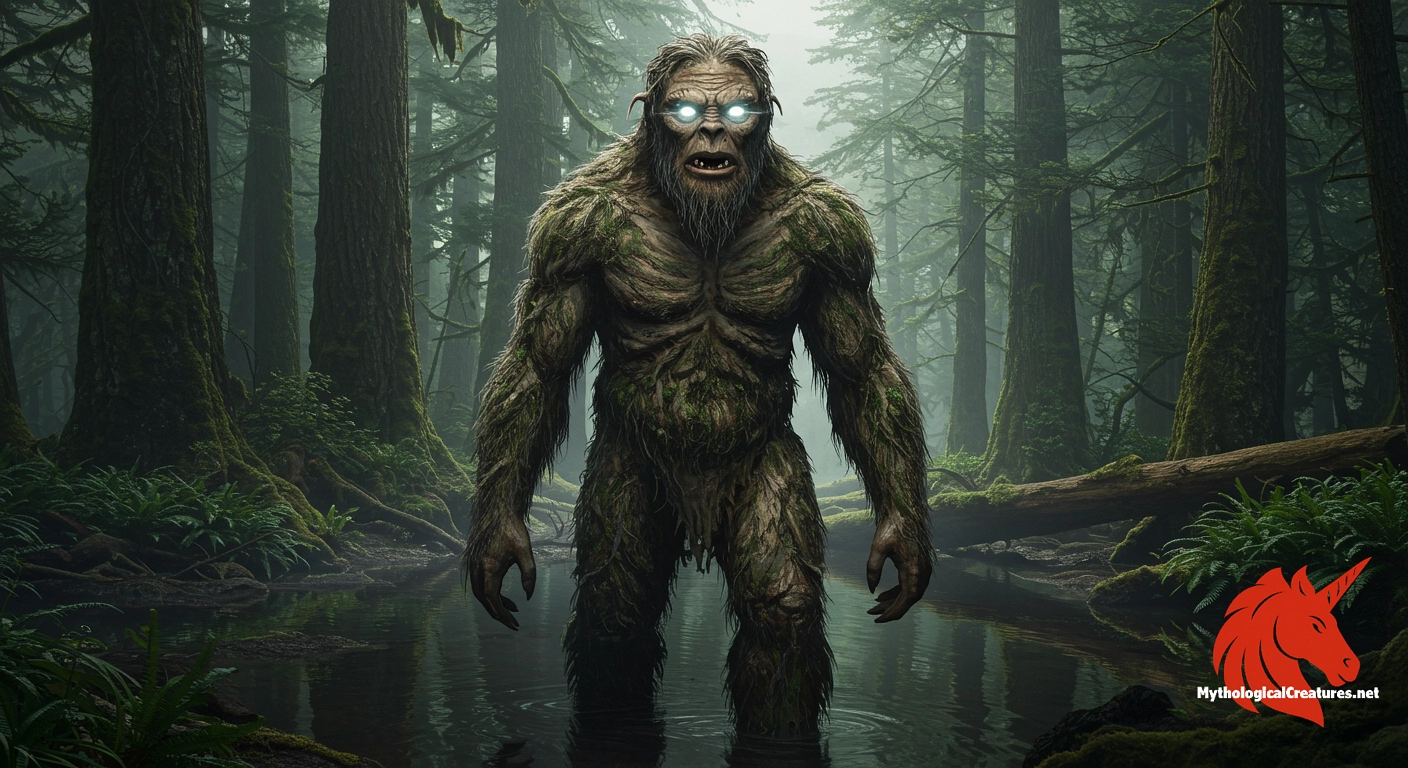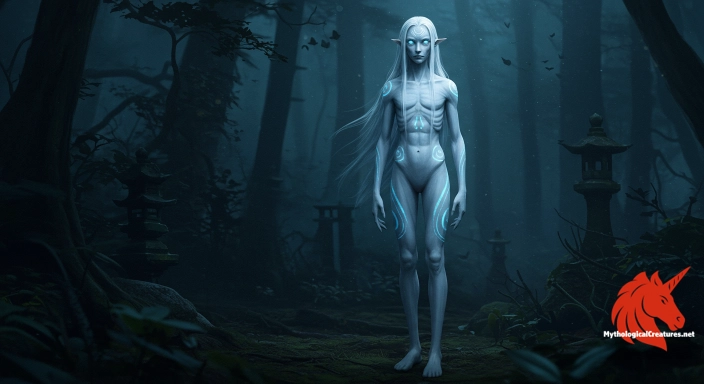Bakwas: Bakwas is a supernatural spirit from Kwakwaka'wakw folklore known as the 'wild man of the woods'.

Bakwas
Bakwas - Bakwas embodies the mysterious interplay between life and death, serving as a reminder of indigenous beliefs regarding the spirit world and transformation
Origins & First Encounters
Bakwas is a mysterious supernatural spirit originating from the coastal traditions of the Kwakwaka'wakw people of British Columbia. Emerging from a vibrant tapestry of indigenous oral lore, he is often referred to as the wild man of the woods, bridging the human realm with that of the ghostly. His first attestations are deeply embedded in ritual narratives and ceremonial recounts that describe journeys into the primeval forest. Many stories depict his home as an invisible haven tucked away among ancient trees, where the spirits of the drowned congregate in eerie communion. He is renowned for offering ghostly sustenance through cockle shells, a practice that symbolically transforms any mortal who consumes it into a being akin to himself. This transformative ability underscores his role as both a guide and a guardian of the boundary between life and the supernatural. The lore surrounding Bakwas is interwoven with themes of danger, transformation, and the inescapable allure of the unknown. His myth encapsulates the Kwakwaka'wakw understanding of nature and spirit, portraying the wilderness as a domain where reality and the otherworld coexist. Over time, Bakwas has come to represent the delicate balance between human vulnerability and the overwhelming power of the natural and spiritual realms.
Source Texts & Tale Variants
The narrative of Bakwas is preserved in a rich collection of indigenous oral traditions that have been passed down through generations by the Kwakwaka'wakw communities. These stories have been recorded not in a single manuscript but in a fluid tapestry of ceremonial performances, songs, and legends, each adding subtle layers to his mythos. Early ethnographic accounts, although fragmentary, capture the essence of a being who lures unwary travellers with ghost food provided in cockle shells. Over time, multiple variants of his tale have emerged across different ceremonies, each version highlighting a unique aspect of his role in the ghost world. Some traditions focus on his ominous nature and his capacity to transform mortals, while others underscore the spiritual symbiosis between him and the natural surroundings. His connection to other mythic figures, such as the often-mentioned consort dzunukwa, further enriches the storytelling fabric. Reports from adjacent cultures have noted similar entities, thereby corroborating the widespread thematic concerns that Bakwas embodies. These primary sources continue to evolve as contemporary storytellers reinterpret ancient customs in a modern light. The fluidity of his narrative testifies to the dynamic character of indigenous mythology and its ability to resonate across generations.
Form & Powers
Bakwas is typically envisioned as a towering, enigmatic figure whose appearance merges both human and animalistic traits. His body is often cloaked in signs of the wild: tangled and windblown hair intermingled with natural elements such as moss and bark, lending him an organic camouflage that is both mysterious and terrifying. His eyes, frequently described as piercing and luminous, seem to reflect an inner fire that connects him to the spectral realm. The wild man’s limbs are portrayed as elongated and agile, echoing his ability to move between the seen and unseen worlds with an uncanny grace. Artists have captured his form as partly shrouded in mist, suggesting that his physicality is as mutable as the forest around him. One of his most distinctive features is the cockle shell he wields, which is not merely a tool but a symbol of his ghostly offering and transformative power. Some renditions depict subtle hints of fangs or clawed extremities, emphasising his connection to the primordial forces of nature. Despite these recurring motifs, his exact appearance is often left ambiguous, as if intended to change with each encounter and cultural retelling. The physical form of Bakwas thereby mirrors the elusive boundary between the material and the magical, inviting continual reinterpretation.
Regional Faces
The legend of Bakwas is primarily rooted in Kwakwaka'wakw culture, yet his myth finds echoes and adaptations across the wider Pacific Northwest. In various local traditions, his characteristics are tailored to reflect the unique spiritual energies of each region, sometimes portraying him as more benevolent and at other times as overtly menacing. For coastal communities in British Columbia, his invisible abode in the forest may be reimagined as a sacred grove or a shadowed enclave tied to ancestral waters. Among the Tlingit, similar spirit beings such as the kushtaka incorporate aquatic elements, blending the lore of land and sea with hints of Bakwas’s transformative nature. The Haida and Nuu-chah-nulth also recount stories of drowned spirit ghosts, where the themes of transformation and spectral allure resonate strongly. These regional adaptations often adjust ritual details—like the form of the ghost food or the nature of the encounters with mortals—to better suit local environmental and cultural contexts. The interpretation of his myth changes subtly from one community to another, reflecting different relationships with the natural world. In some variants, the focus shifts to a redemptive or protective role, while in others the narrative emphasises the peril of crossing forbidden boundaries. The fluidity in his depiction underlines both the diversity and interconnectedness of indigenous mythologies in the region, making Bakwas a dynamic symbol of cultural identity.
Cultural Parallels
Bakwas stands out as part of a broader constellation of mythological figures that capture the archetype of the wild, transformative spirit. His dual nature, straddling the boundary between corporeal existence and the spectral realm, is a theme that resonates with legends found in many cultures around the world. Much like European tales of the wild man or the werewolf, his narrative warns that an encounter with the supernatural can irrevocably alter human existence. Comparable to the kushtaka of the Tlingit and the gagit of the Haida, Bakwas is part of a pan‐Northwest cultural dialogue where spirits mediate between life, death, and nature. These parallels suggest a shared human fascination with the ambiguous figures that dwell in the liminal spaces of the world. Across traditions, the transformative power of contact with such entities is a recurring motif—whether through the consumption of ghost food or other mystical means. The symbolism attached to these figures often speaks to a collective caution and an acknowledgement of nature’s overwhelming, uncontrollable forces. Comparative analysis reveals that while each culture imbues its myths with distinct local flavours, the underlying concerns with mortality, transformation, and the unknown remain universal. Such cross-cultural reflections emphasise a global narrative thread about man’s complex relationship with the unseen and the unexplainable in the natural world. In this way, Bakwas not only belongs to a specific indigenous tradition but also contributes to a larger, interconnected mythos of wild and wondrous beings.
Legacy & Modern Evolution
The myth of Bakwas has evolved remarkably over time, mirroring the shifts in cultural and environmental perceptions within indigenous communities and beyond. Historically, his legend served as an integral part of ceremonial life, symbolising the interplay between life and the spirit world and warning of the transformative dangers inherent in venturing too deeply into the wilderness. With the advent of ethnographic research and increased cross-cultural dialogue, Bakwas has taken on new dimensions as his story has been revisited by both scholars and community elders. Modern reinterpretations often view him as an emblem of the enduring power of ancestral wisdom, merging ancient folklore with contemporary concerns over ecological balance and cultural survival. His ghostly traits and transformative rituals have inspired a spectrum of artistic expression—from traditional wood carvings to modern digital media—that highlight the beauty and mystery of indigenous myth. Emerging narratives emphasise his role as a guardian of natural landscapes, urging respect for the environment and the intangible heritage of cultural memory. In academic and creative circles alike, Bakwas has become a symbol of resistance against cultural homogenisation, representing a vibrant reclamation of indigenous identity. The evolution of his myth reflects a broader tendency among indigenous communities to reassert traditional knowledge systems in a modern context. As a result, Bakwas continues to captivate audiences with his rich, multifaceted symbolism, ensuring that his legacy remains both historically significant and dynamically relevant. In contemporary discourse, he embodies the transformative dialogue between the past and the present, bridging ancestral spirits with modern ecological and cultural narratives.
Interesting Fact
An intriguing aspect of Bakwas is his method of transformation, where the simple act of offering ghost food in a cockle shell becomes a doorway to a supernatural existence, mirroring similar legends among neighboring Pacific Northwest cultures.
Quick Creature Info
Origin:
Features:
Associations:
Our Mythic Legendary Rating:

Also Sometimes Known As:
Habitat:
Supernatural Powers:
Physical Attributes:
Abilities:
Behavior:
Lore:
Related Creatures, Tales or Lore
- kkushtaka
- ggagit
- ppukubts
- bba'wis
References
Discover Another Mythical Legend You May Not Have Heard Of?
Uncover the mysteries of ancient folklore and expand your knowledge of legendary beings from cultures around the world.
Dare to Meet the Aonyōbō....
Curated by the Mythological Creatures Team (rev. May 2025)
